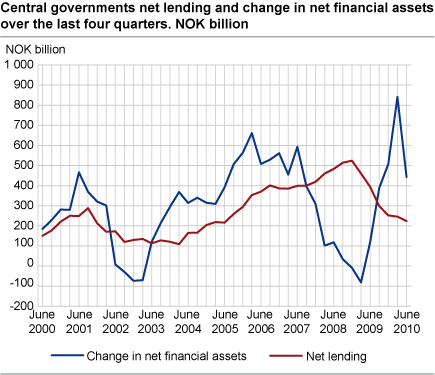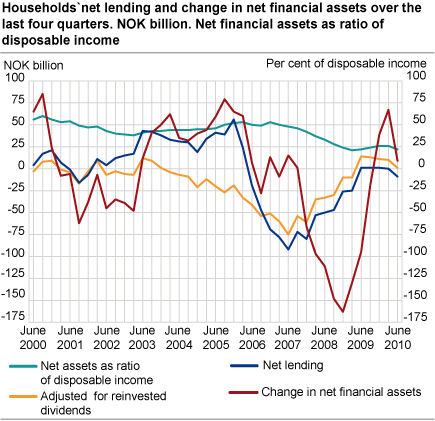Content
Published:
This is an archived release.
Lower revenues slow down investments
Central government’s net lending decreased in the four quarter period to the second quarter of 2010. Corresponding low levels of net lending have not been measured since the first half of 2005, and the main reason is a weakening of the petroleum revenues.
Central government’s net lending fell in line with lower inflows of government petroleum revenue to the Government Pension Fund Global, and net lending is calculated to NOK 224 billion in the last four quarter period. The four quarter development in net lending has diminished since the end of 2008, when central government’s net lending was calculated to NOK 524 billion, which represents a preliminary climax. Net holding gains in the last four quarter period were NOK 218 billion, and the increase in central government’s net financial assets amounted to NOK 443 billion in the four quarter period to the second quarter of 2010.
Central government’s net financial assets fell in the second quarter of 2010
Central government’s net financial assets were NOK 3 917 billion at the end of the second quarter. This is nearly NOK 45 billion lower than at the end of last quarter. This was caused by net holding losses in the securities market, which during the second quarter exceeded the net lending. Central government’s net lending was calculated to NOK 45 billion in the last quarter of 2010.
Households’ net lending is reduced
Households and non-profit institutions serving households’ net lending is calculated to NOK -9 billion in the four quarter period to the second quarter of 2010. Net lending in the previous four quarter period was close to 0. The development in net lending has settled in the four quarter periods from the second quarter of 2009 to the first quarter of 2010.
Households’ borrowing has developed moderately since the end of 2008. In the four quarter period to the second quarter of 2010 the households increased their debt by NOK 126 billion, which is in line with the borrowing in the four quarter period to the first quarter of 2010. At the same time the households reduced their acquisition of financial assets from NOK 126 billion in the previous four quarter period to NOK 117 billion in the last four quarter period. The development can be explained by diminishing investments in securities. During the second quarter of 2010 the households sold out of bonds and mutual fund shares, and the net sale contributed to a decline in securities investments in the last quarter period.
Households’ net holding gains were NOK 18 billion in the last four quarter period. Net financial assets increased by NOK 9 billion during the last four quarters and amounted to NOK 255 billion at the end of the second quarter of 2010.
Local government borrowings have settled
The local government’s net lending in the last four quarter period is calculated to NOK -32 billion, compared to NOK -30 billion in the previous four quarter period. Local government’s borrowing in the last period developed almost in line with the borrowing in the period to the first quarter of 2010. During the last four quarter periods the borrowing settled close to NOK 45 billion. Net holding gains did not change the net financial assets and thereby net debt increased by NOK 32 billion in the four last quarters to the second quarter of 2010. At the end of the quarter, the local government had a net debt of NOK 142 billion.
Financial investments increase Norway’s net financial assets abroad
Norway’s net foreign assets were calculated to NOK 2 326 billion at the end of the second quarter of 2010. This is up by NOK 83 billion from the end of the first quarter of 2010. In the last quarter, Norway’s net lending abroad was NOK 83 billion. Net holding gains due to fluctuations in foreign exchange rates and global security markets did not change net financial assets abroad in the second quarter of 2010.
| 1. quarter 2008 | 2. quarter 2008 | 3. quarter 2008 | 4. quarter 2008 | 1. quarter 2009 | 2. quarter 2009 | 3. quarter 2009 | 3. quarter 2009 | 1. quarter 2010 | 2. quarter 2010 | ||||||||||||||||||||||||||||||||||||||||||||||||||||||||||||||||||||||
|---|---|---|---|---|---|---|---|---|---|---|---|---|---|---|---|---|---|---|---|---|---|---|---|---|---|---|---|---|---|---|---|---|---|---|---|---|---|---|---|---|---|---|---|---|---|---|---|---|---|---|---|---|---|---|---|---|---|---|---|---|---|---|---|---|---|---|---|---|---|---|---|---|---|---|---|---|---|---|---|
| Financial assets | 5 390 | 5 550 | 5 889 | 6 584 | 6 048 | 6 255 | 6 267 | 6 258 | 6 584 | 6 915 | |||||||||||||||||||||||||||||||||||||||||||||||||||||||||||||||||||||
| Liabillities | 4 153 | 4 283 | 4 385 | 4 930 | 4 574 | 4 429 | 4 236 | 4 218 | 4 340 | 4 588 | |||||||||||||||||||||||||||||||||||||||||||||||||||||||||||||||||||||
| Net financial assets / net financial wealth | 1 236 | 1 267 | 1 504 | 1 654 | 1 474 | 1 827 | 2 031 | 2 040 | 2 244 | 2 326 | |||||||||||||||||||||||||||||||||||||||||||||||||||||||||||||||||||||
| Change in net financial assets / net financial wealth | 13 | 31 | 236 | 150 | -180 | 353 | 205 | 9 | 204 | 83 | |||||||||||||||||||||||||||||||||||||||||||||||||||||||||||||||||||||
| Other changes | -87 | -86 | 131 | 23 | -247 | 268 | 138 | -83 | 119 | 0 | |||||||||||||||||||||||||||||||||||||||||||||||||||||||||||||||||||||
| Net lending | 100 | 117 | 105 | 127 | 67 | 85 | 67 | 92 | 84 | 83 | |||||||||||||||||||||||||||||||||||||||||||||||||||||||||||||||||||||
DefinitionsNet lending as defined in non-financial accounts (capital account) = savings + net capital transfers - net acquisition of non-financial assets
Net lending as defined in financial accounts = net acquisition of financial assets - net incurrence of liabilities
Savings is non-consumed income and can be invested in financial or non-financial assets. If savings exceed non-financial investments, a sector has a surplus of funds and becomes a net lender to other sectors. In the financial transaction account, this means that the sector acquires more financial assets than liabilities. On the other hand, if savings are less than non-financial investments, investments have to be funded either by selling financial assets or incurring debts. Household investments in non-financial assets mainly reflect the purchase of new housing and fixed investments by unincorporated enterprises. They typically finance substantial parts of these investments by incurring debt in the form of loans.
Net financial assets (net financial wealth) = total financial assets - total liabilities
The financial balance sheet shows the financial position of a sector at the end of the reference period and is broken down into the categories of financial assets and liabilities. Insurance technical reserves, currency and deposits are the predominant assets held by households, while loans provided by financial corporations (banks etc.) constitute the main proportion of liabilities.
Changes in net financial assets = net lending + other changes in assets, net
The change in the financial balance sheet during the reference period is a result of accumulated financial transactions and other changes in assets. The latter category mainly reflects revaluations due to changes in market prices of financial instruments. |
Tables
Contact
-
Torbjørn Cock Rønning
E-mail: torbjorn.cock.ronning@ssb.no
tel.: (+47) 97 75 28 57
-
Jon Ivar Røstadsand
E-mail: jon-ivar.rostadsand@ssb.no
tel.: (+47) 21 09 43 69
-
Marit Eline Sand
E-mail: marit.sand@ssb.no
tel.: (+47) 40 90 26 74


